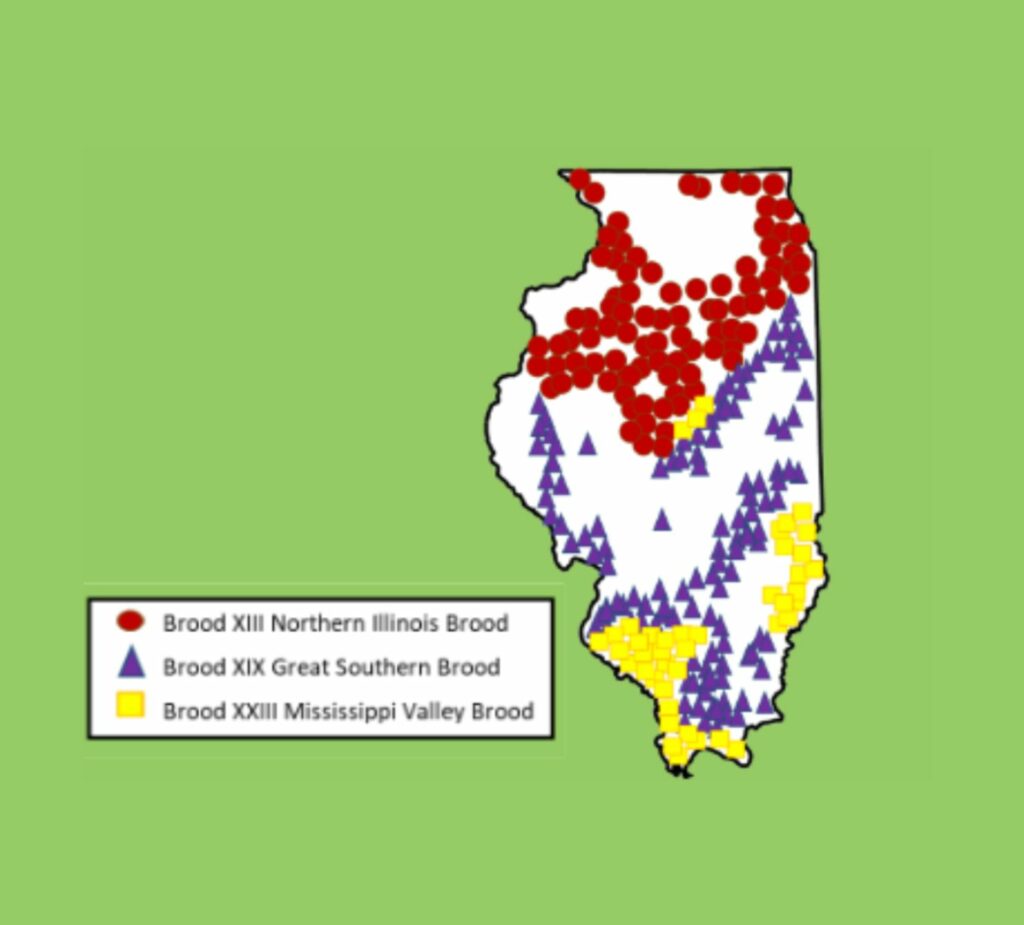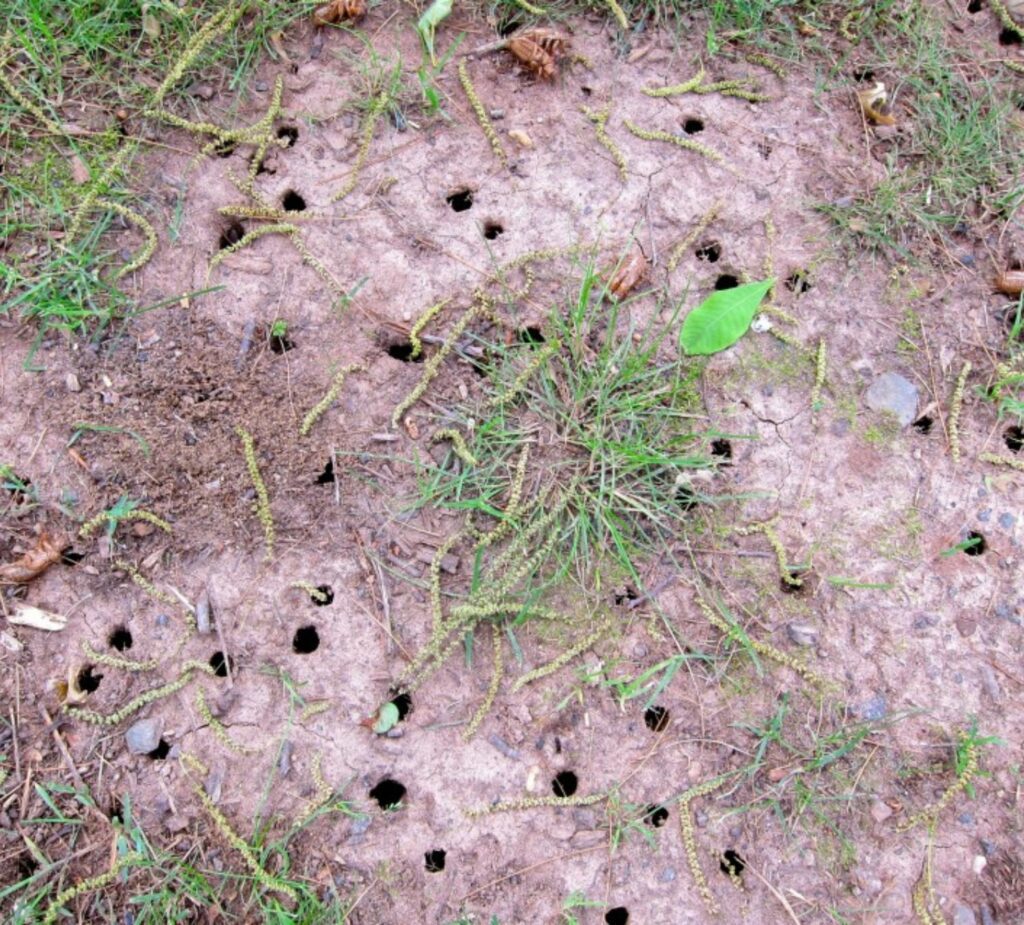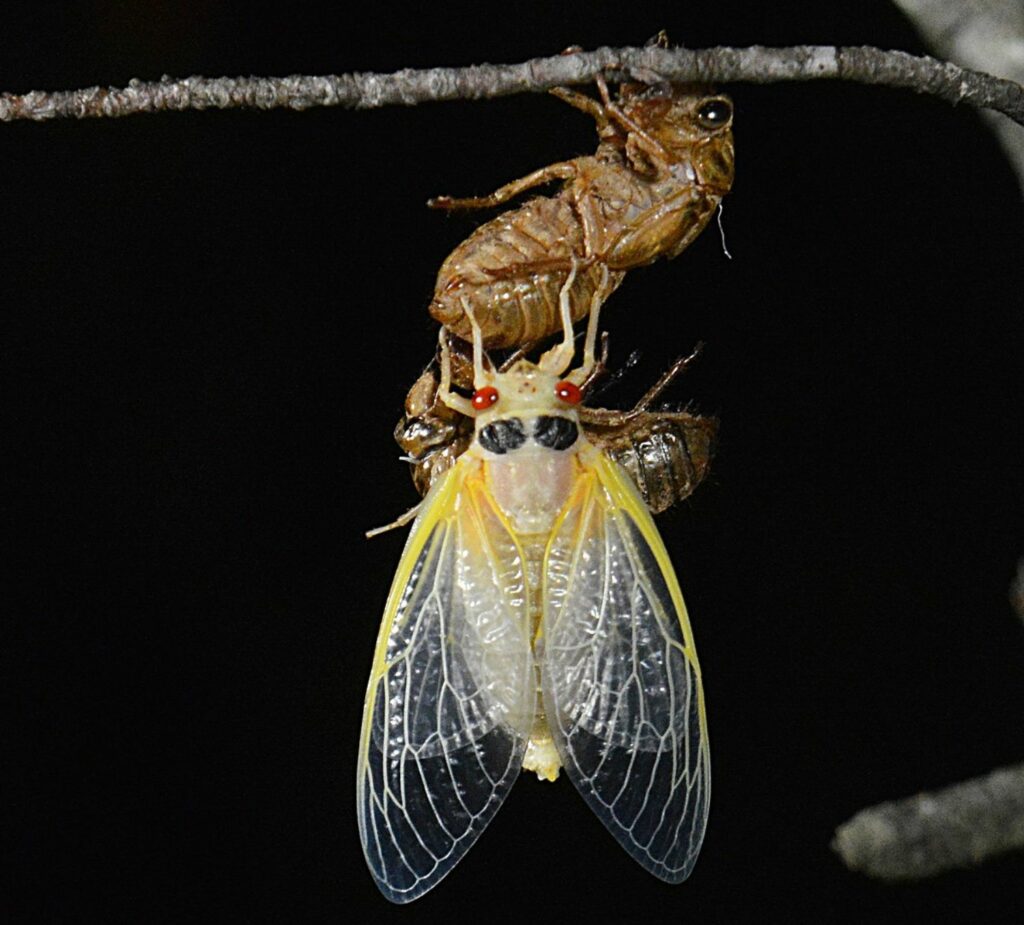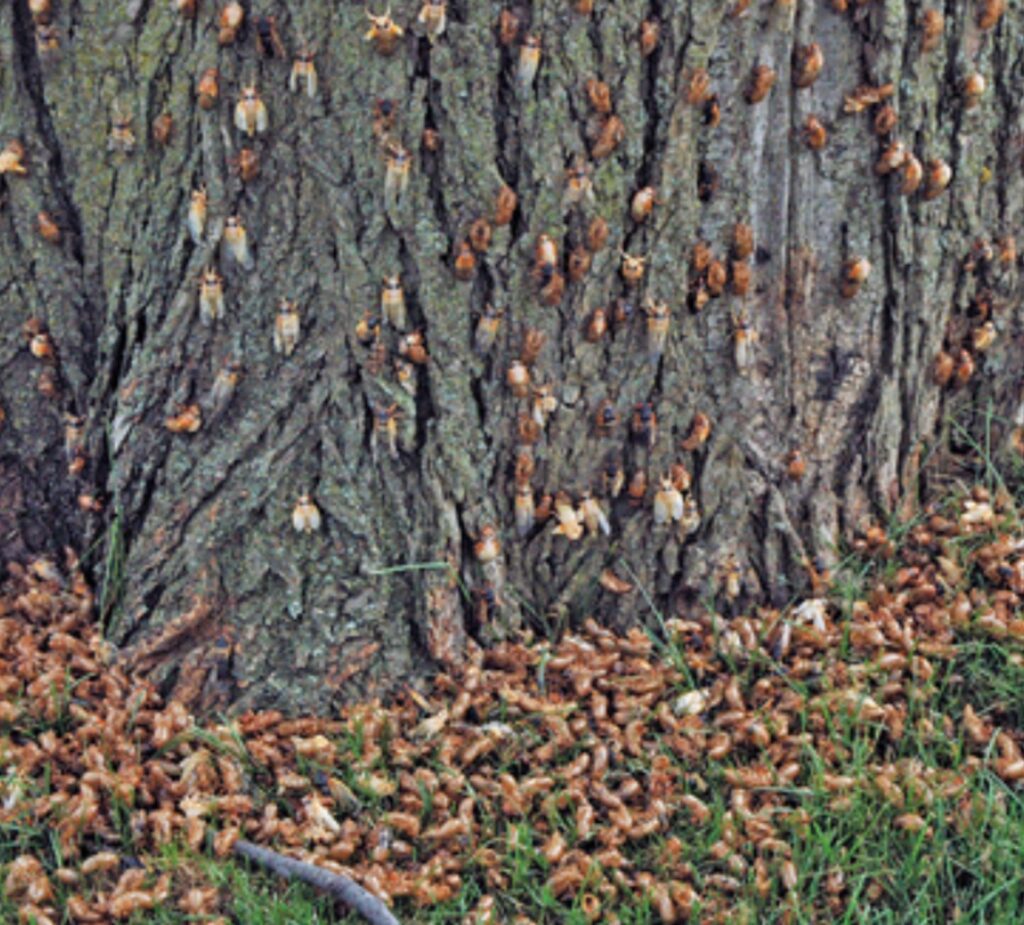
About Cicadas
Sometime in mid-May Northern Illinois will see the emergence of periodical cicadas which only happens once in 17 years. The cicada invasion generally lasts about 4 weeks, so by the end of June it will be all over. Cicadas prefer delicious trees like elm, chestnut, ash, maple, hawthorn, redbud, Oak, but fruit trees, ornamentals and shrubs are also at risk. They pose the largest threat to small, weak trees, shrubs and ornamentals. Cicadas do not eat plants and will do no harm to flowers and new leaves.
Generally, entomologists anticipate about 133,00 cicadas per acre. When millions of cicadas are active at the same time, there are too many for predators like squirrels, skunks, raccoons, foxes, coyotes and many kinds of birds to eat. Periodical cicada fly only a short distance, less than ½ mile from where it emerges from the soil.
Cicada Emergence 2024 – What to Expect
Eastern United States is the only place in the world where periodical cicadas occur, and there are 15 broods, each with a specific emergence year and geographical location of emergence. In Illinois, there are members of 5 cicada broods. In 2024 we will see a remarkable natural phenomenon. There will be the emergence of the Northern Illinois Brood XIII, the Great Southern Brood XIX and a 2028 emergence group, the Mississippi Vally Brood XXIII, that may contain a small number of cicadas that emerge in 2024 called stragglers. They will be primarily in far southern Illinois.
The Northern brood will be emerging in the northern half of Illinois, but also in Indiana, Iowa, Wisconsin and possibly Michigan. The Great Southern Brood will be emerging in the southern half of Illinois, but will also emerge in Alabama, Arkansas, Georgia, Indiana, Kentucky, Louisiana, Mississippi, Missouri, North Carolina, Oklahoma, South Carolina, Tennessee and Virginia. There may be a few places in central Illinois, around Springfield, where the two broods will be emerging in the same area. However, they aren’t expected to overlap to any great extent. This is the first time this has happened since 1803 and it won’t happen again until 2245. The map shows where periodical cicadas broods are expected to emerge.


Cicada Life Cycle
Cicadas spend the majority of that time living underground, feeding on tree roots. Once the soil warms enough in the spring to 64 degrees Fahrenheit at 8 inches deep they will begin to emerge. They emerge from the soil in the evening and will climb up trees or other objects and molt, leaving behind a cicada molten skin. After the adults emerge, they are white, soft and squishy but will darken and harden overnight. Male cicadas will start singing 4 to 5 days after they emerge to attract females to mate.


Cicadas are well known for the sound they make which is a rather repetitive clicking. They are one of the loudest insects in the world. The chirping noise serves as a mating call from the males to the females. The volume needs to be high enough for females to hear the males from a great distance. The sound can travel about 1 mile. Each cicada species has its own distinctive sound to avoid attracting the wrong cicada. Male cicadas generally only make these mating calls during daylight house and the quiet down by nightfall. If temperatures are below 72 degrees Fahrenheit cicadas ease up on the noise because their diaphragms lose elasticity. Females lack structures to produce sound.
After mating, females will lay their eggs in the new growth of woody plants. They prefer branches the width of a pencil or a little larger (up to ½ to 1 inch in diameter). They will use their saw-like organ (ovipositor) to cut into branches and lay 10-20 eggs before moving further down the branch. In total, each female will lay 500-600 eggs. After about a month, the adult cicadas will begin to die. Large piles accumulate under trees and can smell rather unpleasant. Their decaying bodies will serve as fertilizer for plants. Six to 10 weeks after the eggs are laid, they will begin to hatch. Tiny cicada nymphs will fall to the ground and begin feeding, often on grass roots. Over time they will dig down into the soil 8-12 inches deep and feed on tree roots for the next 13 to 17 years. Periodical cicadas are among the longest-lived insects on the planet.


How are Periodical Cicadas Different Than Cicadas We see Every Year?
Annual cicadas are often called dog-day cicadas and appear every summer (July-September) in Illinois. They typically take 2 to 5 years to complete their development because they have overlapping generations and are not synchronized. Annual cicadas are about 1 ½ to 2 ½ inches long and have tree and brown pattern to green and black pattern with a mostly white underside. Periodical cicadas are smaller around ¾ to 1/1/2 inches long. They have black bodies with orange wing veins and red eyes. Cicadas are sometimes mistakenly called locusts. They are not at all related to locusts, which are a kind of grasshopper.
Tips On Protecting Young and Other Vulnerable Trees and Shrubs From Potential Damage
Young, unhealthy older or stressed trees, shrubs and ornamentals could suffer serious damage from the female cicadas egg-laying process. Damage occurs when female cicadas lay their eggs in small slits on twigs. Heavily damaged twigs and small branches may wilt and break off. Some injured branches may not die the first year, but wounded areas will be weak and may eventually break off in a windstorm. On vulnerable trees, shrubs and ornamentals, the slits may not heal and could be entryways for canker diseases or other problems that could impact their future health and lead to future twig death. Healthy mature trees and shrubs can better tolerate cicada twig damage.
For smaller trees, shrubs and ornamentals, preferable after leaves emerge and harden off and before cicadas arrive, cover them with a fine protective netting. Close gaps in the netting with binder clips, clothespins. Gather the fabric around the trunk as near to the ground as possible and secure it. Once the cicada emergence is over, remove the netting. Consider waiting to plant young trees with a trunk diameter of less than 2 inches until after adult cicada activity has ceased or in the fall.
Advanced Tree Care Strategies to protect your trees:
- Protective Netting: Consider covering young trees with fine mesh netting to prevent cicadas from laying eggs in their branches. Be sure to secure the netting tightly at the base of the tree to prevent entry points for the insects.
- Mulching: Apply a thick layer of mulch around the base of your trees to deter cicadas from laying eggs in the soil. Mulch not only helps retain moisture and suppress weeds but also acts as a barrier against egg-laying females.
- Irrigation: Keep trees well-watered, especially during periods of cicada emergence. Adequate hydration can help trees withstand stressors and recover more quickly from any damage caused by cicada feeding.
- Pruning: Trim any dead or damaged branches before cicadas emerge to minimize their impact on tree health. Avoid heavy pruning during the cicada season, as it may attract egg-laying females to freshly cut surfaces.
- Fertilization/Mycorrhizae Root Injections: Consider fertilizing trees before and after cicada emergence to promote healthy growth and recovery. Consult with our certified arborist to determine the appropriate fertilization regimen for your trees.
- Monitoring: Keep a close eye on your trees throughout the cicada season, checking for signs of stress or damage. Early intervention can help mitigate potential issues and preserve tree health.
Ensure that susceptible trees and shrubs are healthy. Consult your Advanced Tree Care arborist to provide you an evaluation of your trees, shrubs and ornamentals. Some of your best defense is proper fertilization treatments to provide trees with important macro-nutrients that support health and vitality. a Mycorrhizae treatment to stimulate new root growth and improve nutrient, mineral uptake and water absorption. Proper tree care along with mulching, watering and addressing any disease problems can help ensure that trees and shrubs stay robust enough to sustain cicada damage.